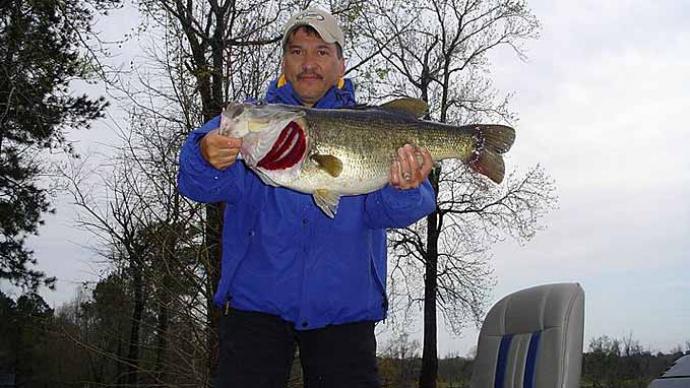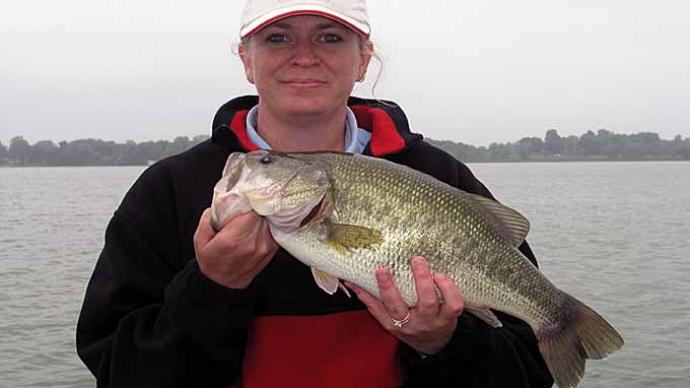
The secret to catching bass in the springtime is being crazy enough to figure them out. From February through April, bass will be in the prespawn and spawning modes. During this time, each day can bring on a whole new set of rules as to where the fish are holding and what you have to do to catch them. You might find fish suspended in 40 feet of water one morning and then in the afternoon they're all up in 5 feet. Springtime's a crazy time of year but it is my favorite time to fish.
When cold fronts have passed through an area in the early spring, the bass go into what I call a "waiting mode." They seem to be waiting for a signal to get active. They'll back off the spawning flats, suspend off ledges or the bases of trees. That's when I'll throw everything from crankbaits to dropshot worms to target and catch fish. Most of the California lakes that I fish regularly act the same way in the spring. If a lake is deep and clear, fish could suspend very deep; on a more shallow lake, the waiting mode might be in 15 feet of water or even less.
Don't be fooled, when you find suspended fish, by thinking they will be there long. The "waiting" period may last for minutes, hours, or days. I can't believe how fast bass can move. People accuse me of being a little wild with the different methods I use to find fish, but in the spring sometimes that's the only way to stay on top of the game. You have to be versatile and creative.
Sometimes, while trying to figure the fish out I'll try a small RoboWorm dropshot worm and a 3-inch dropshot rig. Or I'll drag an area with a heavy splitshot rig and a worm or grub behind. The weight stirs up the bottom and attracts active fish. Reaction baits are important too while finding fish. Bass do strange yet predictable things during the prespawn.
All it takes sometimes is the warming of an afternoon to get the fish moving, and out of their waiting period. Then another cold front moving through will find them playing their waiting game again.
Have you ever noticed sunny days that just feel cold? The sun might be out but it's not warming up? Then, the next day the sun actually begins to penetrate, and it feels really warm. The fish react the same way. You must be aware of the changes in water temperature, air temperature and fish behavior.
I like fishing the secondary points, walls that get a lot of sun, and the warmer water first. At Clear Lake for example, I'll start on the north end of the lake, because it's warmer, and because it has a hard bottom. Don't under estimate the value of a hard bottom. This attracts the prespawn fish. Before the small males have made the beds, I'll throw reaction baits like jigs, crankbaits and rattle-type baits to locate fish. Ripbaits like the Megabass X-110 work well because the fish will at least chase the bait up. My cranking line is P-Line. It's a tough line, great for cranking as well as many other applications.
Once the males make the beds, the females won't be far behind. I love the prespawn before the fish are locked on the bed because they are generally more aggressive and active. Still working outside the bedding area, I'll sometimes get just close enough to see the lighter bottom which shows the beds, but I'll fish water maybe 5 or so feet deeper. My techniques work well for skittish bass as well as bass already "locked" in an area.
Once the bass decide it's time to spawn, first the males, and then the females lock on the bed. Then I concentrate on their movements. Many times the females will not be right on top of the bed. They are off to one side, or in the general area. I might again throw a ripbait through the bed to attract their attention. But, by far my favorite bait for beds is either a tube, or Zipper grub, or full-sized Zipper worm. I'll back off and make a 20- to 30-foot cast and let my bait either settle onto the bed or throw past the bed and bring my bait through it.
My rigging might surprise some of you. I don't generally use the long flipping and pitching sticks. My rod is 6- foot 6-inches long with a medium/light action. Then, I use 50-pound SpiderWire. The extra feel I get is incredible, and I can pull fish through whatever cover is there. I like the shorter rod because I can control it so much better, and again, the action helps with feeling the hits.
A Texas-rigged 5/0 Gamakatsu hook with a 1/4-ounce weight finishes off my tackle. My choice of baits - tube baits, Zipper grubs and worms fall on the beds in a very natural way. They are soft-bodied and the hook penetrates the fish easily. My favorite colors are black and chartreuse.
Reprinted with permission from Bass West Magazine




